 Back to the Be Inspired Blog
Back to the Be Inspired Blog
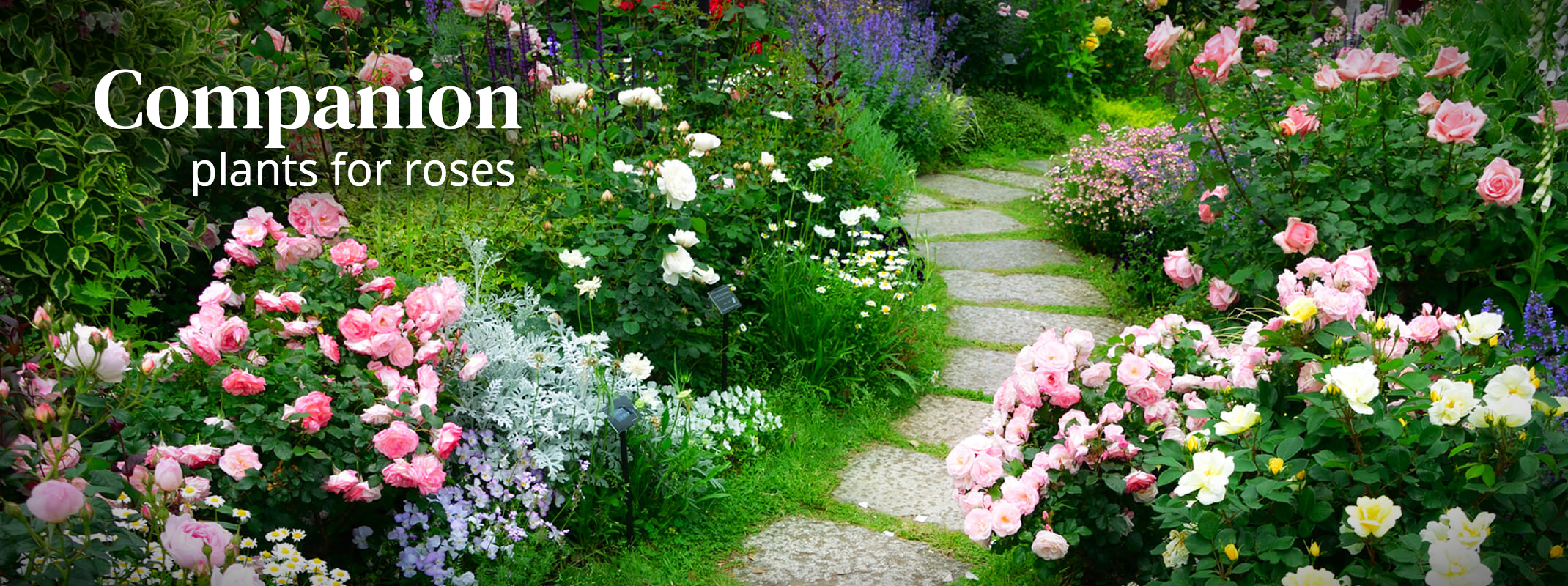
Companion Plants For Roses
Roses are one of the most stunning flowers on the planet. Even with their thorns, they hold power and beauty that you just can’t deny.
Even though roses are lovely on their own, everyone and everything needs a companion. Keep reading below for the best plants to pair with a rose garden to deter pests, diseases and more.
Top Companion Plants for Roses
Best Plants for Pest Control
Before you reach for the sprays with harsh chemicals, consider rooting these plants next to your roses to keep pests away.
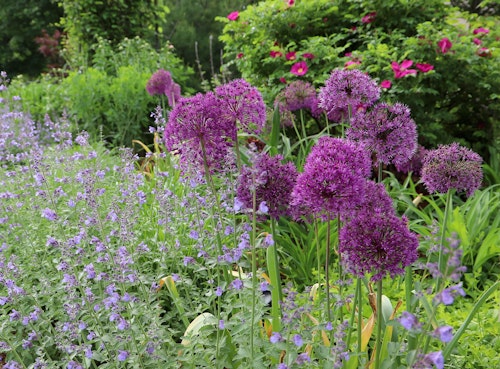
Allium Family
We love the allium family to protect roses. As Gardenia explains, they are, “Reliable, they come back year after year, are easy to grow and undemanding, and many outstanding varieties harmonize with early blooming roses.”
The allium family includes:
- Allium “Gladiator” (Ornamental Onion)
- Allium “Globemaster” (Ornamental Onion)
- Allium cristolphis (Star of Persia)
- Allium hollanicum “Purple Sensation” (Ornamental Onion)
- Allium schenoprasum (Chives)
Gardenia also notes, “Chives are easy to grow and look very charming among shrub roses.” Leeks are also a great relative of the chive to grow next to roses.
Garlic
Another one of our top recommendations is garlic. According to Birds and Blooms, “Garlic protects roses from not only bad bugs, it can also help prevent fungal diseases. Aphids [don’t] love garlic, in fact, they hate it! Ants and snails aren’t huge fans of garlic either. In addition, studies show that garlic has anti-fungal properties, which helps keep fungal diseases like blackspot at bay.”
Garlic is also helpful in enhancing the fragrance of your roses and keeping snakes and moles away. Garlic is a natural snake repellent and if you use whole or crushed garlic next to mole tunnels, the intense smell will force them to leave the area; it’s such a great natural and non-toxic method.
Ideal Herbal Companions to Roses
Herb gardens are a favorite for many to grow and now you can use them to help your roses grow as well as add them to your favorite dishes. Along with mint and thyme, the following herbs are great for deterring pests, especially aphids.
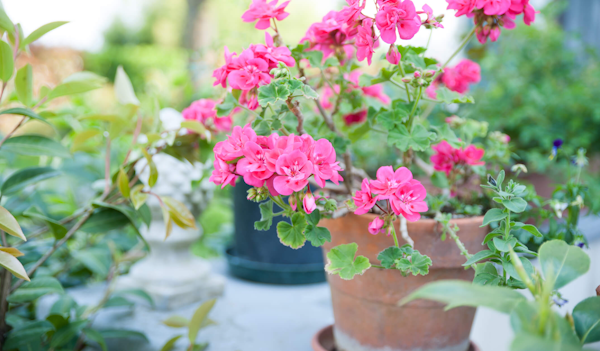
Scented Geranium Varieties
We also recommend Geraniums as a perfect rose companion. Gardenia notes, “They are great at insinuating themselves among the bare legs of roses and help reinforce the beauty of their romantic blooms and prevent diseases. There are numerous species of Geranium and cultivars in white, blues, pinks and mauves.”
The members of the Geranium family include:
- Geranium “Brookside” (Cranesbill)
- Geranium “Johnson’s Blue” (Cranesbill)
- Geranium “Rozanne” (Cranesbill)
- Geranium pratense “Mrs. Kendall Clark” (Meadow Cranesbill)
- Geranium psilostemon (Armenian Cranesbill
- Geranium x magnificum (Purple Cranesbill)
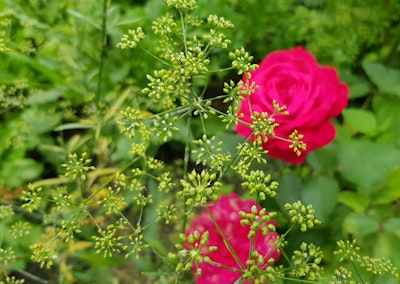
Parsley
Along with protecting your roses against aphids and other pests, parsley can also attract helpful insects. Gardening Know How notes, “Swallowtail butterflies lay their eggs on the leaves, encouraging a new generation of butterflies to grow up in your garden. Parsley flowers attract hoverflies, the larvae of which eat aphids, thrips, and other harmful insects. Some harmful beetles are also repelled by the presence of parsley.”
Another benefit of parsley being planted next to roses is that, like garlic, it will make your flowers smell sweeter.
Tomatoes
Another top companion to the rose is the tomato. The Spruce explains that tomatoes “Protect roses from black spot. You can interplant or use a spray. [For the] spray: Liquify tomato leaves and then dilute them with 4-5 pints of water, add a tablespoon of cornstarch. Use spray on rose leaves, when you can't plant tomatoes next to them.”
Attractive Flower Companions for Roses
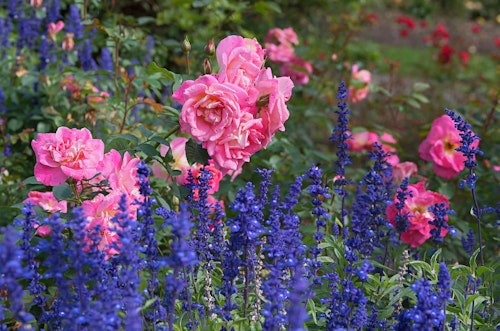
What’s better than growing one flower? Growing another beautiful flower next to it! Lavender is a terrific option for your garden; below is more information about the benefits and varieties of this bloom.
Perennial Varieties
These beautiful scented flowers are high on the list of our favorite rose companions. Gardenia names Nepeta (Catmint), hardy Salvia (Sage) and Lavandula angustifolia (English Lavander) as the varieties that are most popular to plant alongside roses. They also note that these perennials are easy to grow and “Make the roses appear more vibrant than they would on their own… [they also] cover the exposed knees of your rose bushes without covering their rose blooms and attract a huge number of insects, especially bees and hoverflies.”
Lavender is also helpful at keeping rabbits away.
The perennial companion varieties include:
- Lavandula angustifolia “Hidcote” (Lavender)
- Lavandula angustifolia “Lavenite Petite (Lavender)
- Lavandula angustifolia “Munstead” (Lavender)
- Nepeta “Six Hills Giant” (Catmint)
- Nepeta racemosa “Walkers Low”
- Salvia nemorosa “Caradonna” (Sage)
- Salvia x sylvestris “Blue Hill” (‘Blauhugel’ Sage)
- Salvia x sylvestris “Mainacht” (Wood Sage)
- Salvia x sylvestris “Tanzerin” (Wood Sage)
What to Grow Beneath Roses
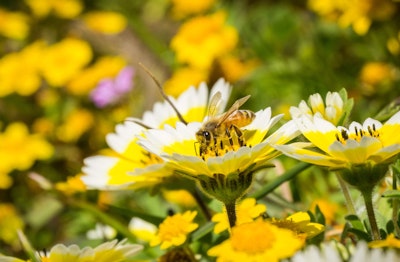
One thing to consider when growing a rose bush is that roses grow can leave gaps and openings near the stems of the plant; this is often called being “leggy.” Gardening Know How describes this as when “Roses shed all their lower foliage, leaving nothing but their canes showing. The foliage and blooms are all up higher on the bush, making the lower portion bare and lacking a nice eye-catching look that we like for our gardens.”
Gardening Know How also notes, “When adding companion plants to the rose beds, it is wise to choose plants that do not have an unruly or spreading growth habit. Look for those that have a more well-behaved growth habit, perhaps even a growth habit that is similar to the roses themselves. Ensure that the under planting rose companions are at least 12 to 18 inches away from the rose bushes to avoid disturbing their root systems. Roses do not like having to compete for available nutrients, water or sunlight, so keep this in mind with your companion plantings.”
Flowers to Grow to Help Fill in Openings
Which flowers should you grow to cover up the openings from your rose stems? Here is a list of our favorite perennials to choose from:
- Anise
- Hyssop
- Bellflower
- Catmint
- Baptisia
- Phlox
- Lilies
- Russian sage
- Wormwood
- Yarrow
- Marigolds
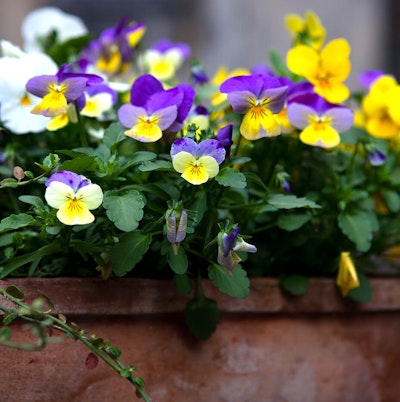
Annuals
For a list of annuals you can plant alongside your roses, here's what we recommend:
- Annual Phlox
- Alyssum
- Heliotrope
- Millionbells
- Pansies
Expert Tip: Make sure the varieties chosen will not grow bigger than your roses. You do not want the roses to be shaded as a result.
6 Gardening Tips for Roses
One of the most important aspects of gardening with roses is using the right tools and handling them properly. We recommend following these guidelines:
- Bypass blade hand pruners (or hand shears) are most versatile for roses. Use them on rose shrubs with limbs of 1/2" diameter or smaller. Some pruners are made to handle up to 1” diameter limbs.
- Use lopping shears (long-handled pruning shears or a pruning saw) for cuts larger than ½”. If your tool is too small for too big a cut, the wood will splinter, allowing access for pests and disease and potentially damaging your tools. Loppers are the most useful tools for almost all larger pruning jobs. Use pruning saws for very large cuts on old rose shrubs with large limbs. Pruning saws have a handle with an 8” to 15” curved saw blade with teeth set wide, about 6 per inch.
- Keep your tools sharp. Clean, accurate cuts mean minimal damage and better healing.
- Clean your tools. We recommend that you clearn your tools with a 10% bleach solution or spray them with rubbing alcohol between rose shrubs or after cutting unhealthy areas.
- Set the tools on something. We recommend that you set your tools on something other than the ground to prevent picking up fungus or pathogens.
- Prune well below the infected area. If you are pruning out disease, be sure to prune well below the infected area of the plant.
6 Pruning Tips for Roses
- Remove dead or damaged wood. They act as magnets for pests and diseases.
- Cut off suckers growing from roots. The new growth of a grafted rose will not be the same as the rest of the plant.
- Remove spindly or very old growth. Canes thinner than a pencil aren’t strong enough to support top growth. Thick, very old canes are not vigorous.
- Prune canes that rub or are near rubbing. Rubbed areas are easy entry points for pests and diseases.
- Trim remaining canes. For canes that you will keep, make a 45° angle cut above an outward facing bud.
- Remove foliage. Strip remaining leaves by hand to remove leaf and leaf stem, where overwintering insects could hide.
Stop to Smell the Roses
Roses are one of the most beautiful and popular flowers to both grow and receive. To make sure your flowers grow the best they can, it helps to plant companion flowers and herbs next to them. These companion plants range from garlic, tomatoes marigolds and more.
Questions?
Do you still have questions about the best companion plants for roses? We’ve got your answers! Stop by your local SummerWinds Nursery and speak with one of our Trusted Garden Advisors.



